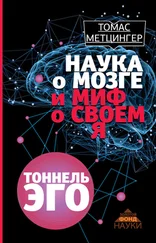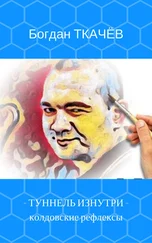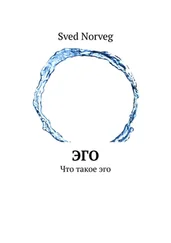Томас Метцингер - Туннель Эго
Здесь есть возможность читать онлайн «Томас Метцингер - Туннель Эго» весь текст электронной книги совершенно бесплатно (целиком полную версию без сокращений). В некоторых случаях можно слушать аудио, скачать через торрент в формате fb2 и присутствует краткое содержание. Жанр: Биология, на русском языке. Описание произведения, (предисловие) а так же отзывы посетителей доступны на портале библиотеки ЛибКат.
- Название:Туннель Эго
- Автор:
- Жанр:
- Год:неизвестен
- ISBN:нет данных
- Рейтинг книги:4 / 5. Голосов: 1
-
Избранное:Добавить в избранное
- Отзывы:
-
Ваша оценка:
- 80
- 1
- 2
- 3
- 4
- 5
Туннель Эго: краткое содержание, описание и аннотация
Предлагаем к чтению аннотацию, описание, краткое содержание или предисловие (зависит от того, что написал сам автор книги «Туннель Эго»). Если вы не нашли необходимую информацию о книге — напишите в комментариях, мы постараемся отыскать её.
Thomas Metzinger — The Ego Tunnel. The Science Of The Mind and The Myth Of The Self
Перевод с английского: Вячеслав Михайлов http://www.nwethik.com
Туннель Эго — читать онлайн бесплатно полную книгу (весь текст) целиком
Ниже представлен текст книги, разбитый по страницам. Система сохранения места последней прочитанной страницы, позволяет с удобством читать онлайн бесплатно книгу «Туннель Эго», без необходимости каждый раз заново искать на чём Вы остановились. Поставьте закладку, и сможете в любой момент перейти на страницу, на которой закончили чтение.
Интервал:
Закладка:
16. Diana Raffman, Language, Music, and Mind (Cambridge, MA: MIT Press, 1993).
17. P. Churchland, «Eliminative Materialism and the Propositional Attitudes,» Jour. Phil. 78(2):67–90 (1981).
18. Quoted after the extensively revised 1991 edition by M. David Enoch and Hadrian N. Ball, Uncommon Psychiatric Syndromes (London: Butterworth-Heinemann, 1991), 167.
19. I am grateful to Dr. Richard Chapman of the University of Utah's Pain Research Center for pointing out to me the concept of an «immunculus»: the network of natural autoantibodies targeting extracellular, membrane, cytoplasmic, and nuclear self-antigens. The repertoires of natural auto antibodies are surprisingly constant in healthy persons and, independently of gender and age, are characterized by only minimal individual variations.
CHAPTER 3
1. M. Botvinick & J. Cohen, «Rubber Hand 'Feels' Touch That Eyes See,» Nature 391:756 (1998).
2. K. C. Armel & V. S. Ramachandran, «Projecting Sensations to External Objects: Evidence from Skin Conductance Response,» Proc. Roy. Soc. Lond. 270:1499–1506 (2003).
3. M. R. Longo et al., «What Is Embodiment? A Psychometric Approach,» Cognition 107:978–998 (2008).
4. See Antonio Damasio, The Feeling of What Happens: Body, Emotion, and the Making of Consciousness (London: Vintage, 1999), 19. See also A. D. Craig, «How Do You Feel? Interoception: The Sense of the Physiological Condition of the Body,» Nat. Rev. Neurosci. 3:655–666 (2002) and «Interoception: The Sense of the Physiological Condition of the Body,» Curr. Opin. Neurobiol. 13:500–505 (2003).
5. For an excellent recent review-including a new, empirically informed synthesis-of the classical intuition of David Hume (that the self is just a bundle of impressions and everything can be explained «bottom-up») as opposed to the classical Kantian intuition (self-consciousness is a necessary prior condition for experiencing the body as a whole and everything must be explained «top-down»), see F. De Vignemont et al., «Body Mereology,» in Gunther Knoblich et al., eds., Human Body Perception from the Inside Out (New York: Oxford University Press, 2006).
6. The terminology was never entirely clear, but it frequently differentiated between an unconscious «body schema» and a conscious «body image.» The body schema (a notion introduced in 1911 by Sir Henry Head and Gordon Holmes, two British neurologists) would be a functional entity, providing an organized model of the bodily self in the brain, whereas the body image would also include our conscious perceptions of our own body as well as thoughts about and attitudes toward it. For a philosophical perspective on the conceptual confusion surrounding both notions, see Shaun Gallagher, How the Body Shapes the Mind (New York: Oxford University Press, 2005). For an excellent review of the empirical literature, see A. Maravita, «From 'Body in the Brain' to 'Body in Space': Sensory and Intentional Components of Body Representation,» in Knoblich et al., Human Body Perception (2006).
7. A. Maravita & A. Iriki, «Tools for the Body (Schema),» Trends Cog. Sci. 8:79–86 (2004). An excellent recent overview is A. Iriki & O. Sakura, «The Neuroscience of Primate Intellectual Evolution: Natural Selection and Passive and Intentional Niche Construction,» Phil. Trans. R. Soc. B 363:222941 (2008).
8. See A. Iriki et al., «Coding of Modified Body Schema During Tool-Use by Macaque Post-Central Neurons,» Neuroreport 7:2325-30 (1996); and Maravita & Iriki, «Tools for the Body (Schema)» (2004).
9. J. M. Carmena et al., «Learning to Control a Brain-Machine Interface for Reaching and Grasping by Primates,» PLoS Biology 1:193–208 (2003).
10. Here is how Iriki and Sakura put this important point: «If external objects can be reconceived as belonging to the body, it may be inevitable that the converse reconceptualization, i.e., the subject can now objectify its body parts as equivalent to external tools, becomes likewise apparent. Thus, tool use may lead to the ability to disembody the sense of the literal flesh-andblood boundaries of one's skin. As such, it might be precursorial to the capacity to objectify the self. In other words, tool use might prepare the mind for the emergence of the concept of the meta-self, which is another defining feature of human intelligence.» See Iriki & Sakura, «The Neuroscience of Primate Intellectual Evolution,» 2232 (2008).
11. See O. Blanke & T. Metzinger, «Full-Body Illusions and Minimal Phenomenal Selfhood,» Trends Cog. Sci. 13(1):7-13 (2009).
12. See T. Metzinger, «Out-of-Body Experiences as the Origin of the Concept of a 'Soul,'» Mind and Matter 3(1):57–84 (2005).
13. E. R. S. Mead, The Doctrine of the Subtle Body in Western Tradition (London: John M. Watkins, 1919).
14. It is important to be clear about the potential ontological conclusions: Even if a fully reductive explanation of all subtypes of OBEs should be achieved-and even if my hypothesis about the history of the concept of a soul is correct-it still remains logically possible that souls do exist. True, we would no longer need the concept of a soul for the purposes of science or philosophy; it would no longer figure in any rational, data-driven theory about the human mind. Logical possibility is something very weak, but it is hard to prove the nonexistence of something, and it always remains possible that one day we will discover a new sense in which the soul is not an empty concept at all.
15. It is interesting to note how the earliest historical meaning of the word «information» in English was the act of informing, or giving form or shape to the mind. What I call the «self-model» is exactly this: the «inner form» an organism gives to itself, the shaping of a mind.
16. Susan J. Blackmore, Beyond the Body: An Investigation of Out-of-theBody Experiences (London: Granada, 1982).
17. In addition to Beyond the Body, see S. Blackmore, «A Psychological Theory of the Out-of-Body Experience,» Jour. Parapsychol. 48:201–218 (1984); and S. J. Blackmore, «Where Am I? Perspectives in Imagery and the Out-of-Body Experience,» Jour. Mental Imagery 11:53–66 (1987).
18. E. Waelti, Der dritte Kreis des Wissens (Interlaken: Ansata, 1983), 18, 25. English translation by T. Metzinger.
19. C. S. Alvarado, «Out-of-Body Experiences,» in E. Cardena et al., eds., Varieties of Anomalous Experience: Examining the Scientific Evidence (Washington, DC: American Psychological Association, 2000).
20. See, for example, J. Palmer, «A Community Mail Survey of Psychic Experience,» Jour. Am. Soc. Psychical Res. 73:21–51 (1979); S. Blackmore, «A Postal Survey of OBEs and Other Experiences,» Jour. Soc. Psychical Res. 52:225–244 (1984).
21. See Alvarado, «Out-of-Body Experiences» (2000) for an overview of many studies; Blackmore, «Spontaneous and Deliberate OBEs: A Questionnaire Survey,» Jour. Soc. Psychical Res. 53:218–224 (1986); Harvey J. Irwin, Flight of Mind (Metuchen, NJ: Scarecrow Press, 1985), 174 ff; O. Blanke & C. Mohr, «Out-of-Body Experience, Heautoscopy, and Autoscopic Hallucination of Neurological Origin: Implications for Neurocognitive Mechanisms of Corporeal Awareness and Self Consciousness,» Brain Res. Rev. 50:184–199 (2005).
22. O. Devinsky et al., «Autoscopic Phenomena with Seizures,» Arch. Neurol. 46:1080-8 (1989).
23. See, for example, P. Brugger, «Reflective Mirrors: Perspective-Taking in Autoscopic Phenomena,» Cog. Neuropsychiatry 7:179–194 (2002); Brugger et al., «Unilaterally Felt Presences: The Neuropsychiatry of One Invisible Doppelganger,» Neuropsychiatry, Neuropsychology, and Behavioral Neurology 9:114–122 (1996); Brugger et al., «Illusory Reduplication of One's Own Body: Phenomenology and Classification of Autoscopic Phenomena,» Cog. Neuropsychiatry 2:19–38 (1997); Devinsky et al., «Autoscopic Phenomena» (1989).
Читать дальшеИнтервал:
Закладка:
Похожие книги на «Туннель Эго»
Представляем Вашему вниманию похожие книги на «Туннель Эго» списком для выбора. Мы отобрали схожую по названию и смыслу литературу в надежде предоставить читателям больше вариантов отыскать новые, интересные, ещё непрочитанные произведения.
Обсуждение, отзывы о книге «Туннель Эго» и просто собственные мнения читателей. Оставьте ваши комментарии, напишите, что Вы думаете о произведении, его смысле или главных героях. Укажите что конкретно понравилось, а что нет, и почему Вы так считаете.








